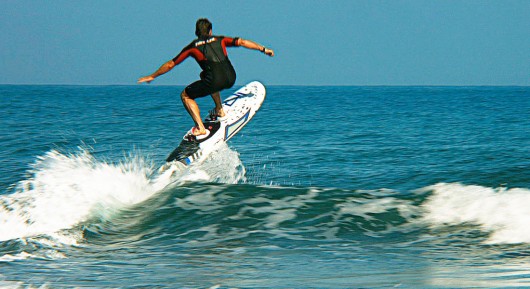 Doc Brown would be totally amped about these new power rides. Forget the ankle busters and crazy shore-breaks, you can carve some epic rides in the flats or even on rivers or lakes. Below are a handful of the latest jet boards to hit the shores as a followup to the leashed power board of 2005 http://www.gizmag.com/go/3871/. 1. The WaveJet came out in 2012 as a booster for big wave riders. Check out the Garrett McNamara video below at Sunset Beach 2. Aquila : The new water sport. Electric Powered Motor Board
Doc Brown would be totally amped about these new power rides. Forget the ankle busters and crazy shore-breaks, you can carve some epic rides in the flats or even on rivers or lakes. Below are a handful of the latest jet boards to hit the shores as a followup to the leashed power board of 2005 http://www.gizmag.com/go/3871/. 1. The WaveJet came out in 2012 as a booster for big wave riders. Check out the Garrett McNamara video below at Sunset Beach 2. Aquila : The new water sport. Electric Powered Motor Board  3. Electric powered wakeboard by RADINN £11,000 electric ‘surfboard’ lets you glide along the sea – and even rivers – at speeds of up to 30mph • The Radinn board has a wireless control, and is made of carbon fibre • It features a jet propulsion system and is powered by lithium batteries • The 64lb (29kg) board reaches speeds of up to 30mph (46km) • Swedish-designed board has a wireless control, and is made of carbon fibre • It is undergoing further tests before pre-orders will begin later this year • The board is expected to retail for €15,000 (£11,800 or $20,000) in early 2015 The whole board, including battery, weighs 64lb (29kg) and the firm claims it is small enough to fit in a car or boat. Battery life is currently around 30 minutes when travelling at full speed, but tests are being carried out to improve this RADINN BOARD SPECIFICATIONS The Radinn whole board, including battery, weighs about 64lb (29kg) and the firm claims it is small enough to fit in a car or boat. Speed is controlled by a wireless remote and the current model can travel up to 25 knots (29mph or 46 km/h). Battery life is currently around 30 minutes when travelling at full speed, but tests are being carried out to improve this. The whole board, including battery, weighs about 64lb (29kg) and the firm claims it is small enough to fit in a car or boat. Speed is controlled by a wireless remote and the current model can travel up to 25 knots (29mph or 46 km/h). But, the firm said the final version is being designed to go faster. Battery life is currently around 30 minutes when travelling at full speed, but tests are being carried out to improve this as well. Radinn, which is a portmanteau of Radical Innovation, is based Ideon Science Park, Lund in the south of Sweden. The firm is carrying out further tests of the board before pre-orders begin later this year, and the device is due to go into production in early 2015. The Radinn is not the first jet-powered board, German-based Lampuga produces its own electric motor that can be fitted to boards, for example, for €13,600 (£10,000 or $17,500). A prototype was developed, alongside partner Alexander Lind, and engineers Oskar Odén and Filip Böttcher, and the first electric powered wakeboard was revealed in May 2014. The Radinn board features a saltwater-resistant jet-propulsion system, and is powered by lithium batteries contained in a waterproof pocket. Riding the waves has been given a boost, literally, thanks to the latest electric-powered wakeboard. The Radinn board is made of lightweight carbon fibre and travels at up to 25 knots (29mph or 46 km/h) – meaning users don’t need a boat to get up to speed. The Swedish designers unveiled the board at the Cannes Yachting Festival earlier this month and it is set to retail for €15,000 (£11,800 or $20,000) when it goes on sale next year. Scroll down for video
3. Electric powered wakeboard by RADINN £11,000 electric ‘surfboard’ lets you glide along the sea – and even rivers – at speeds of up to 30mph • The Radinn board has a wireless control, and is made of carbon fibre • It features a jet propulsion system and is powered by lithium batteries • The 64lb (29kg) board reaches speeds of up to 30mph (46km) • Swedish-designed board has a wireless control, and is made of carbon fibre • It is undergoing further tests before pre-orders will begin later this year • The board is expected to retail for €15,000 (£11,800 or $20,000) in early 2015 The whole board, including battery, weighs 64lb (29kg) and the firm claims it is small enough to fit in a car or boat. Battery life is currently around 30 minutes when travelling at full speed, but tests are being carried out to improve this RADINN BOARD SPECIFICATIONS The Radinn whole board, including battery, weighs about 64lb (29kg) and the firm claims it is small enough to fit in a car or boat. Speed is controlled by a wireless remote and the current model can travel up to 25 knots (29mph or 46 km/h). Battery life is currently around 30 minutes when travelling at full speed, but tests are being carried out to improve this. The whole board, including battery, weighs about 64lb (29kg) and the firm claims it is small enough to fit in a car or boat. Speed is controlled by a wireless remote and the current model can travel up to 25 knots (29mph or 46 km/h). But, the firm said the final version is being designed to go faster. Battery life is currently around 30 minutes when travelling at full speed, but tests are being carried out to improve this as well. Radinn, which is a portmanteau of Radical Innovation, is based Ideon Science Park, Lund in the south of Sweden. The firm is carrying out further tests of the board before pre-orders begin later this year, and the device is due to go into production in early 2015. The Radinn is not the first jet-powered board, German-based Lampuga produces its own electric motor that can be fitted to boards, for example, for €13,600 (£10,000 or $17,500). A prototype was developed, alongside partner Alexander Lind, and engineers Oskar Odén and Filip Böttcher, and the first electric powered wakeboard was revealed in May 2014. The Radinn board features a saltwater-resistant jet-propulsion system, and is powered by lithium batteries contained in a waterproof pocket. Riding the waves has been given a boost, literally, thanks to the latest electric-powered wakeboard. The Radinn board is made of lightweight carbon fibre and travels at up to 25 knots (29mph or 46 km/h) – meaning users don’t need a boat to get up to speed. The Swedish designers unveiled the board at the Cannes Yachting Festival earlier this month and it is set to retail for €15,000 (£11,800 or $20,000) when it goes on sale next year. Scroll down for video
4. Waterwolf electric surfboard Not every surfer is lucky enough to live near a world-class break. In fact, many would-be surfers live hundreds of miles from the nearest piece of coast. For them, the new MXP-3 from Germany’s Waterwolf represents the chance to transform the local lazy lake or river into a riveting surfer’s playground. Part surfboard, part personal watercraft, the MXP-3 zips clean across flat water at speeds up to 21 mph (35 km/h). Unlike the WaveJet, the Waterwolf MXP-3 isn’t an e-power-assisted wave surfboard; it’s not really designed for waves at all. Instead, the board untethers you from wave and wind conditions and lets you “make your own wave.” It’s a sport that’s best described as electric moto-surfing. The MXP-3 is powered by a 5 kW, water-cooled motor driving a propeller in back. The 20 Ah lithium-ion battery, which is housed in a watertight case, provides enough run time for about 20 to 25 minutes of water play or 8 km (5 mi) of range before requiring a three-hour charge. Waterwolf says that its propeller drive is fine-tuned for quick, sure turning and maneuvering, and the board’s shape and construction are also optimized for performance under driven power.  The moto-surfer controls the MXP-3’s output and speed via a Bluetooth handheld throttle, referring to the top-mounted LCD screen for speed and battery information. As a safety precaution, the board has a magnetic emergency kill switch that’s activated at the pull of the wrist leash. Should the rider fall off, the tug of the strap pulls the magnetic connector out, cutting power immediately. Compared to other powered surfboards like the PowerSki JetBoard, the MXP-3 has a simple, electric design and comparatively light 53 lb (24 kg) weight. Based on the video below, it looks like an absolute blast, even if it doesn’t boast the speeds of gas-powered competitors. Much like an electric car, the MXP-3 does suffer from limited range syndrome. We can’t imagine that many folks will get this thing in the water and not want to play with it for more than 20 minutes at a time. They might find themselves yearning for a gas engine once the power bar pulls a quick vanishing act, though Waterwolf mentions that the battery is exchangeable, so we assume it will sell back-up batteries for extending water time. Waterwolf showed the MXP-3 at the recent Dusseldorf boat show and plans to launch it this May. The board will be available in 94- and 96-in (240- and 245-cm) lengths for €6,990 (US$9,560), which includes VAT. For those that want to try before they buy, Waterwolf plans to host a demo center at its Oberammergau, Germany headquarters. The surfer controls the output by way of a wireless remote control worn on the wrist. The wireless system keeps the surfer’s hands free and doesn’t tie him to the board. The wristband also monitors battery level and cuts propulsion off if the surfboard gets more than a leash length away from surfer. The rechargeable lithium-ion battery gives you 30 to 45 minutes of run time, and since you’re not actively using it the entire time, that translates to much more actual time on the water. WaveJet inventor Mike Railey enjoyed tow-in surfing when he first tried it back in the late 90s, but didn’t like the hassle of having to rent out a tow-in vehicle. The existing motorized boards were too heavy for his liking, so he got to tinkering on the compact, lightweight add-on that became known as the WaveJet. After receiving several patents for the model, Railey introduced WaveJet last year. Surfers, professional lifeguards and other industry professionals have been testing it, and the first commercial run will hit the market next month. The WaveJet will be offered in surfboard, boogie board and stand-up paddle board varieties this year, with kayak and other models to follow next year. Big wave surfer and WaveJet ambassador Garrett McNamara was using a traditional tow-in system when he set the world record for biggest wave (90 feet/ 27.4 m) ever surfed last November, but he did use the WaveJet to catch a 50-footer (15.24 m) on the same trip to Portugal. While WaveJet was inspired by big waves, the system is also useful beyond surfing. When used in rescue boards, it allows lifeguards to get to victims more quickly while conserving energy. Serving as a lightweight motor on a kayak or boat, the WaveJet’s flat design means it doesn’t need any clearance and can be used in shallow water. It can also help boaters to battle strong currents. WaveJet deliveries will begin in mid May. The WaveJet pod retails for US$2,500 on its own, for use with WaveJet-ready or retrofitted boards. Recreational board packages start at $4,395, and rescue board packages at $4,150. Pre-orders involving a $500 deposit are open now.



